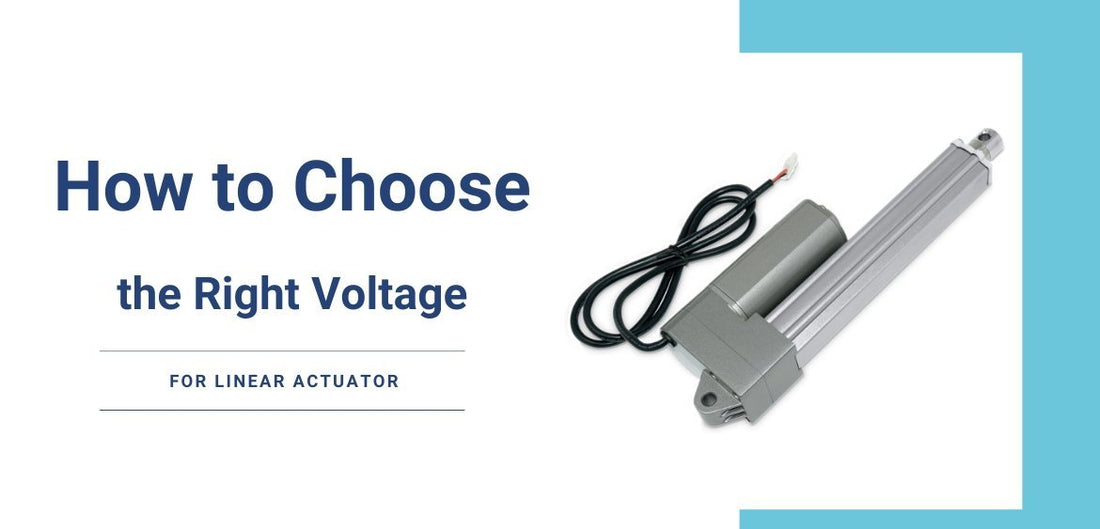When it comes to choosing the right actuator voltage, it is crucial to consider the number of variables that will enable it to operate at its full potential. These main considerations include the available actuator current, voltage, power (i.e. choosing an appropriate power supply), voltage drops, as well as the speed and force you require from the linear actuator.
Moreover, it is not just the quantity of voltage being supplied that is important, but also the quality. Knowing the difference between the unregulated power supply, a linear power supply, and switching power supply could save you in this regard. Instead of becoming confused with the array of varied technical information online, our essential guide will walk you through all electrical considerations to ensure you are equipped with the knowledge to make the best buying decision.
Power Availability
Actuator voltage can be supplied in two ways – either with a large battery or, more commonly, a power supply. Linear power supplies take in alternating current (AC) and output direct current (DC) through a series of steps, as follows:
- AC passes through a step-down transformer to lower the voltage.
- A full-bridge rectifier cuts the negative polarity of the AC signal.
- A circuit, consisting of parallel-connected capacitors, smooth the signal to create a DC-like voltage output.
- A regulator produces a specific constant output voltage.

Unregulated power supplies do not have a regulation circuit and, therefore, produce a rippled output voltage, which is undesired if you require a precise voltage. Nevertheless, if an affordable solution for a low-voltage electric actuator source is required, then unregulated power supply is the way to go.
Linear power supplies tend to not be highly efficient as they dissipate a large amount of heat when the regulator tries to knock down the voltage and keep it constant. Therefore, when opting for a voltage for the actuator, it is best to stick with a switching power supply.
Switching Power Supplies
Switching power supply uses semiconductor switching techniques, as opposed to linear regulation, to produce a specific output voltage. They are far more efficient (i.e. less heat dissipation) and are often lighter due to the use of a smaller transformer.
Number of Actuators
It is also important to consider how many linear actuators you intend to use when selecting a power supply. If linear actuators are connected in series, the actuator voltage of the power supply is shared among them. For example, if you have two 12VDC linear actuators connected in series and connected to a 12VDC power supply, each linear actuator would only receive 6VDC, which would mean the actuators are running at half their capacity – not ideal.
On the contrary, connecting those two linear actuators in parallel would simply double the current draw but keep the voltage the same, which is fine as long as your power supply’s rated current is not exceeded. If more than one linear actuator needs to be powered, especially if they vary in electrical characteristics, then it is good practice to use separate power supplies for each.
Voltage Drops
In some cases, a power supply and linear actuator could be located quite far apart, requiring a lengthy cable. This can cause a voltage drop across the cable due to the internal resistance of the wire. The basic equation to calculate the voltage drop across a cable is as follows:

Where:
– voltage drop [V].
– cable length [m].
– current [A].
– copper resistivity [Ω∙mm2/m].
– cross-sectional area of the cable [mm2].
For example, a linear actuator voltage of 12VDC at 8A (full load) is used. A power supply, rated at 12VDC 10A, is used but with a 50m copper cable (4mm2 cross-sectional area) connected to the linear actuator. Using the above equation, the voltage drop is 1.7V by using a resistivity of 0.017*. Therefore, the linear actuator would only be running at a supplied voltage of 10.3V.
*The resistivity of copper at 20°C, whereby, the voltage drop would increase by approximately 0.4% per °C increase.
This voltage drop can be much higher if you take into consideration correction tables, internal controller/driver voltage drops, and other electrical losses due to cable connectors. Therefore, when selecting the right voltage for your linear actuator, you should consider the voltage drops.
One way to minimize the voltage drop is to increase the cross-sectional area of the cable, thereby, reducing the internal resistance. Alternatively, cables can be buried underground to avoid direct sunlight and prevent fluctuating voltage drops due to varying cable temperatures throughout the day.
Furthermore, to illustrate the importance of using a copper cable versus a steel or aluminum cable, the graph below shows that a copper cable has the lowest voltage drop across its length.

Speed and Force
Slower linear actuators generally mean a higher force output and vice versa. However, a higher voltage is one of the indicators that mean the linear actuator’s motor is more powerful, and more force can come from it. On the contrary, a low-voltage electric actuator motor can also be paired with gearing to speed up the linear actuator or increase its output force.
Either way, it is important to select the right actuator voltage so that it can operate at its peak performance. Then, during operation, the speed and force can be decreased by using a controller to decrease the voltage, if needed.
Progressive Automations’ Options
Two main options exist – select a power supply with the right voltage for your linear actuator or opt for a voltage-customized (voltage changing actuator) linear actuator that is right for your power supply. Regarding the latter, Progressive Automations primarily offer 12VDC linear actuators, but there are models that go up to 24VDC, 36VDC, and 48VDC. Furthermore, the PA-12 can be customized to 7.5VDC if a low-voltage electric actuator power supply is being used.
Progressive Automations also offer power supplies suited to their linear actuators, making the selection process simpler. As previously discussed, ensure the power supply has a high enough voltage to operate the linear actuator. If the actuator is rated at 12VDC, then use a 12VDC power supply, provided they are close together, otherwise opt for a higher voltage power supply to account for losses. Also, ensure the power supply’s current is higher than the current draw of the linear actuator at full load, otherwise, you run the risk of the power supply overheating.
Conclusion
It is evident that selecting the right voltage for your actuator will ensure it performs efficiently and at its rated speed and force. By knowing to look out for voltage drops across your cabling, the type of power supply being used, and the desired speed/force you require, you can be sure that you are making the right decision.




